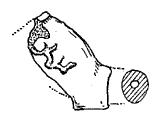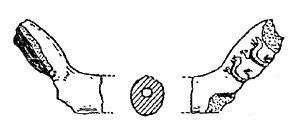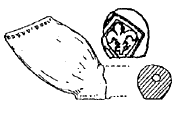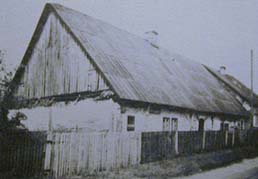No. 4/1991, p. 1-4
Walter Morgenroth: Casselmann's clay-pipe factory in Grossalmerode
The Casselmann family of clay-pipe makers can be demonstrated to
have worked in the pottery town of Grossalmerode in N. Hesse since
the 17th century. Christoph Wilhelm Jacob Gatterer's book, on which
this article is based, describes Casselmann's factory at the end
of the 18th century and provides details of the different stages
of production, quoting wages and prices for individual products.
|

|
No. 4/1991, p. 4-12
Bernd Thier: The clay pipes found in the moat of Lüdinghausen
castle
The 56 clay-pipe fragments found in 1986 in the moat of Lüdinghausen
castle date predominantly from the 17th century. The marks suggest
that they were mostly made in Gouda. There is no definite evidence
that any of German manufacture are present.



Pipe with heel, double-cone bowl with ornament
in relief, ?Dutch, beginning of 17th century
|

Pipe with diamond-shaped fleur-de-lis heel mark, Holland,
first half to mid 17th century

|
No. 4/1991, p. 12-18
Edward Zimmermann/Martin Kügler: Save the Zborowskie clay-pipe
factory, the last left in Poland!
In 1752 a clay-pipe factory was founded in the village of
Zborowskie (Soborowsky, from 1874 to 1945 called Ostenwalde),
north of Lublinitz in Upper Silesia. The fact that clay-pipe
makers were hired from the Netherlands brought the factory
considerable prosperity and it employed over 100 workers in
1783. It was the largest clay-pipe factory in Silesia up to
1816, since it was protected from competition by privileges.
It closed down around 1860-70 after a slow decline. The buildings
(workshops and workers' houses) are acutely threatened as
they are falling into decay.
|
|

The pipe factory building in Sborowsky in its present state
|
|
